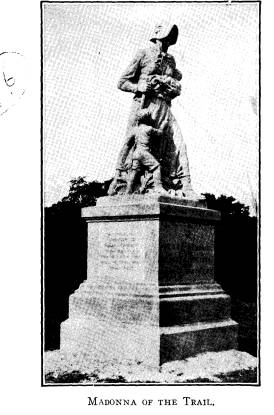Ohio History Journal
OHIO'S MADONNA OF THE TRAIL
BY MRS. LIDA KECK-WIGGINS
Ohio's Pioneer Mother Statue,--"
the Madonna of
the Trail," is located three miles
west of Springfield on
the grounds of the State Masonic Home.
The statue
is a warm pink in color and is moulded
of Missouri
granite as the main aggregate in the
poured mass of
"algonite" stone. The
foundation upon which it stands
is two feet above ground, and the
monument is 18 feet
tall. The design is of a pioneer
mother, clad in garb
suitable for the frontier life. She
wears a feminine-
looking bonnet, and on her left arm is
an infant. Her
right holds a musket. To her skirts
clings a small boy.
Her feet tread upon cacti. The
expression of the face
is one in which are skillfully mingled
everlasting mother-
love and courage born of the
necessities of the frontier.
The Ohio statue, emplaced on July 4,
1928, was the
first of twelve to be dedicated along
the National High-
way. The figure was designed by Mrs.
John Trigg
Moss of Kansas City, Missouri, National
Chairman,
National Old Trails Road Committee of
the Daughters
of the American Revolution. The statues
were made by
Mr. H. Leimbach, sculptor of St. Louis.
The beautiful
parking about the Ohio statue was done
by Arthur
Leedle, architectural consultant. The
ground, donated
by the State Masonic body, is high and
was somewhat
barren, but by adroit treatment of the
soil, the placing
Vol. XLI--11. (161)
|
162 Ohio Arch. and Hist. Society Publications of a serpentine wall of West Virginia brick in a half- circle about the statue, and the softening of the base- lines with carefully selected shrubbery, a noble effect has been attained of which Ohio may well be proud. A |
|
|
|
stairway of the brick leads down to the highway. Mrs. O. H. Anderson, Chairman Old Trails Road Committee, had this work in charge for the Lagonda Chapter, D. A. R. The twelve statues are identical, and have been placed as follows: First at Springfield, Ohio, July |
Ohio's Madonna of the Trail 163
4, 1928; second, Wheeling, West
Virginia, July 7, 1928;
third, Council Grove, Kansas, September
7, 1928;
fourth, Lexington, Missouri; fifth,
Lamar, Colorado,
September 24, 1928; sixth, Albuquerque,
New Mexico,
September 27, 1928; seventh,
Springerville, Arizona,
September 29, 1928; eighth, Vandalia,
Illinois, October
26, 1928; ninth, Richmond, Indiana,
October 28, 1928;
tenth, Washington, Pennsylvania,
December 8, 1929;
eleventh, Uplands, California, February
1, 1929; and
twelfth, Bethesda, Maryland, April 19,
1929.
The history of "how the statues
came to be" is of
intense interest to all Americans.
Memorialized by the
National Society Daughters of the
American Revolu-
tion, Congress appropriated a sum to
build a National
highway over the Old Trails, made by
the wagon-wheels
of the pioneers from Maryland to
California. The Na-
tional Society D. A. R. promised, on
its part, to mark
appropriately this trail. The
intention, at the outset,
was to use money collected from all the
states, to bear
the expense of placing thousands of
markers. Eventu-
ally, after the road was finished, (at
the expense of the
Government up to a point just outside
Springfield, Ohio,
from which place the states bore the
expense) it was
found that automobile associations,
towns and individ-
uals had very satisfactorily marked the
trail. Hence
the D. A. R. was forced to think out
some individual
way to spend $12,000 collected for the
purpose. To
Mrs. John Trigg Moss, the National
Chairman Old
Trails Road Committee, fell this task.
She designed
the figure which later was unanimously
accepted by the
National society.
A committee composed of members of the
D. A. R.
164 Ohio Arch. and Hist.
Society Publications
and of the National Old Trails Road
Committee, which
Society proffered its services in
working out the great
plan, visited all the towns along the
Trail, and decided
which of these cities offered the most
important Revo-
lutionary War or other historic data.
To the city so
qualifying went the state statue.
Springfield won for
Ohio. The site selected (a knoll on the
Ohio Masonic
Home grounds) was considered the
logical place because
it marks approximately the spot where
the National
Pike, as constructed by the National
Government, ended,
and also is in reasonably close
proximity to the legendary
site of the birth of the great Indian
warrior, Tecumseh.
This location, also, is near the
battlefield of Piqua where
the power of the Shawnees was
effectually checked by
General George Rogers Clark in August,
1780. The
statute erected here is, incidentally,
but three miles from
the site of the George Rogers Clark
monument, erected
a few years ago by the State of Ohio on
the Piqua bat-
tlefield. The importance of this battle
to the National
Society D. A. R. is that it was the
most important one
of the American Revolution, fought on
Ohio soil.
Each of the statues cost $1,000 to
build, but the
expenses of the transportation,
setting-up, and erecting
were borne by the cities where the
monuments were
placed.
The program for the Ohio Madonna was in
charge
of A. D. Hosterman. Mrs. C. C. Cory,
Regent of La-
gonda Chapter, led in the salute to the
flag. Music
followed. Reverend J. Bradley Marward,
a prominent
Lutheran clergyman, pronounced the
invocation. This
was followed by the raising of the flag
near the statue
by William C. Shultis, Commander of the
American
Ohio's Madonna of the Trail 165
Legion, officiating. General J. Warren
Keifer, only
living Civil War general and ex-Speaker
of the House
of Representatives, then unveiled the
statue, followed
immediately by the playing of "The
Star-Spangled Ban-
ner" by the boys of the Ohio
Masonic Home band. Mrs.
John Trigg Moss delivered the
dedicatory address and
presented the statue to Ohio. John B.
McGrew re-
sponded for the Ohio Masonic body, and
Mrs. Frank
W. Hartford, retiring regent Lagonda
Chapter D. A.
R. for the local D. A. R. Mrs. Walter
L. Tobey, then
state vice-regent, now regent, Ohio D.
A. R., and Mrs.
Lowell F. Hobart, organizing secretary
general D. A.
R., spoke, as did also Judge Harry S.
Truman of Inde-
pendence, Kansas, president of the
National Old Trails
Road Association. Mrs. Lida Keck
Wiggins of La-
gonda Chapter read an original poem
entitled "The
Madonna of the Trail." This was
followed by the for-
mal address, delivered by Judge D. D.
Woodmansee, of
Cincinnati.
Before reading her poem Mrs. Wiggins
requested
that Miss Carrie M. Zimmerman
(historian of Lagonda
Chapter, whose briefs concerning the
suitability of
Springfield to receive the Madonna,
effected that result),
come to the platform. Miss Zimmerman
did so, and
the entire concourse applauded
heartily.
Miss Zimmerman gave credit to Dr. B. F.
Prince,
member of the Ohio State Archaeological
and Historical
Society, W. W. Keifer, attorney, and
director of the
Clark County Historical Society, and
Mr. A. L. Slager,
secretary of the Clark County
Historical Society, who
counseled her in preparing her data.
|
166 Ohio Arch. and Hist. Society Publications On the sides of the Ohio Madonna statue are chis- eled these inscriptions: "The National Road--completed by the Federal Government to this point in 1839. From this point westward built by the States through which it passes." "Three miles southwest of here General George Rogers Clark, commanding Kentucky Frontiersmen, vanquished the Shawnee confederacy August 8, 1780, resulting in Opening the Northwest Territory." |
|
|

